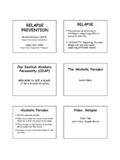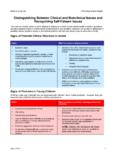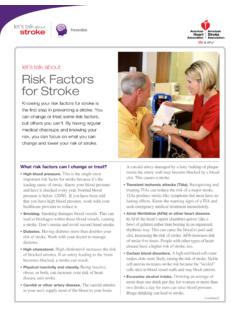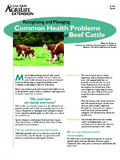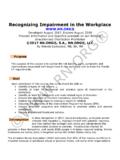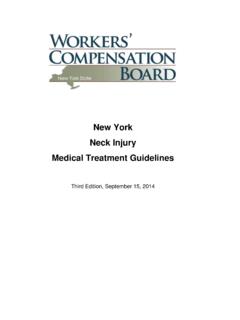Transcription of Myasthenia Gravis: Clinical Guidelines
1 1 Myasthenia gravis : Clinical Guidelines Introduction There have been a number of publications on Guidelines on MG diagnosis and treatment, and there are slightly different approaches and practices according to the authors experience and target audience. Our Guidelines are directed to European clinicians with little experience on MG (GPs, other clinicians, and neurologists) working in different countries and conditions and under different health policies. The first aim of these recommendations is to help improve Clinical practice in general, from symptoms to diagnosis, including diagnostic criteria, classification, differential diagnoses, and associated conditions. The second aim is to advice on general management and treatments from first-line medications to immunosuppression and immunomodulation, to provide guidance on how to monitor MG patients and how to recognize and prevent exacerbations or crises, and also to list conditions and medications that can interfere with MG.
2 In addition, these Guidelines should help towards recognizing Clinical stability while patients are still on medication and how to plan a very slow reduction of the medication and prevent relapses that may occur even in patients in MG remission. As a final point, we want to stress the importance of having good and easy communication routes between patient and GP and specialist. Communication via letters, FAX, phone calls, and emails is crucial in the diagnosis and effective treatment of MG patients, and helps build mutual confidence. These recommendations were prepared in the context of the WP5 of the EuroMyasthenia project and took into account comments and suggestions from D Hilton-Jones in Oxford and some of our partners (A. Melms, J. Verschuuren, Apostololski, M. Farrugia, A. Kostera-Pruszczyk, T. Chantall, F. Deymeer, I.)
3 Hart, N. E. Gillus, and M. Carvalho) 2 1. Myasthenia gravis diagnosis This section includes: Background Rationale Diagnosis, classification and assessment Diagnosis flowchart for MG MGFA Clinical classification. Background Myasthenia gravis (MG) is a neuromuscular transmission disorder characterized by fluctuating weakness and fatigability of voluntary muscles (ocular, bulbar, limbs, neck and respiratory) without loss of reflexes or impairment of sensation or other neurologic function. The neuromuscular transmission defect is usually demonstrated by pharmacological and electrophysiological tests. MG is an autoimmune disorder and is usually (80% of MG patients) mediated by autoantibodies to the acetylcholine receptor (AChR, AChR-MG); in the 20% of patients that are not positive for AChR antibody, up to 50% have antibodies to muscle specific kinase (MuSK, MuSK-MG).
4 The remaining patients are negative for both antibodies (SNMG), but evidence is accumulating which strongly indicates that other, as yet unidentified, autoantibodies are responsible for SNMG. The diagnosis is based on Clinical appraisal and confirmed by one or more pharmacological, electrophysiological, or serological tests. Imaging studies are essential to search for a thymoma. 3 Cholinesterase inhibitors and immunosuppressive treatment are effective in most cases and the response to plasma exchange and IVIg is often remarkable. Response to treatments may be helpful in confirming the diagnosis in those patients with undetectable autoantibodies. Rationale A firm diagnosis prevents inappropriate treatments and their side effects, allows rapid implementation of MG-targeted treatment, and can redirect patients without MG for correct diagnosis.
5 Standardisation of Clinical assessment and the objective recording of Clinical and laboratory findings contribute to improving the Clinical diagnosis and characterization of MG, definition of subsets of the disease, and evaluation and measuring of its Clinical and functional features either at diagnosis or after treatment. The standardization of Clinical data helps also in the development and improvement of different lines of investigation: Clinical , epidemiological and laboratory. Diagnosis, classification and assessment Diagnostic criteria (inclusion) A. Characteristic signs and symptoms Diplopia, ptosis, dysarthria, weakness in chewing, difficulty in swallowing, muscle weakness of limbs with preserved deep tendon reflexes, weakness of neck flexion and more rarely extension, weakness of trunk muscles, and respiratory symptoms with respiratory failure.
6 Increased weakness during exercise and repetitive muscle use with at least partially restored strength after periods of rest. 4 Clear improvement in strength following administration of a cholinesterase inhibitor (edrophonium or neostigmine). Positive response to immunosuppressive treatment. Dramatic improvement following plasma exchange or IVIg. B. Decremental response of compound muscle action potential upon repetitive stimulation of a peripheral nerve (RSN): in MG, repetitive stimulation at a rate of 2-3 Hz per second shows a characteristic decremental (>10%) response which is reversed by edrophonium (Tensilon) or neostigmine (although this is not required for routine assessment). Single-fiber studies show increased jitter (see annexe on electrodiagnostic tests). C. Antibodies to AChR or to MuSK Exclusion/differential diagnosis Congenital myasthenic syndrome, myopathies ( oculopharyngeal muscular dystrophy, mitochondrial progressive external ophthalmoplegia), steroid and inflammatory myopathies, motor neuron disease Eaton-Lambert syndrome Multiple sclerosis (weakness with chronic fatigue or subacute/acute brainstem or spinal cord motor involvement) Variants of Guillain-Barr syndrome ( , Miller-Fisher syndrome) Organophosphate toxicity, botulism, black widow spider venom Stroke Hypokalemia.
7 Hypophosphatemia Associations (MG is often associated with) Thyroid abnormalities Other autoimmune diseases 5 Thymoma Ascertainment As a general rule, a firm diagnosis is based upon a characteristic history and physical examination plus: Presence of serum anti-AChR or anti-MuSK antibodies 2-3 Hertz repetitive nerve stimulation with decrement (single nerve fiber electromyography (SFEMG) with jitter studies may be needed), although, with a typical Clinical picture and positive antibodies, electrophysiology is not required for diagnosis. It should be noted that EMG and sometimes also SFEMG show no clear abnormalities in MuSK-MG patients. Nevertheless, SFEMG is sometimes helpful in monitoring response to treatment. Therefore, if available, electrophysiology studies should be performed as they are generally helpful and a good support for diagnosis and possibly for response to treatment.
8 If all the above investigations are negative: Very clear positive response to immunosuppressive treatment and/or plasma exchange or IVIg Unequivocally positive Tensilon or neostigmine test (with precautions against respiratory/cardiac complications), although some false positivity may occur Classification Required data for Clinical and laboratory classification Demographic data Basic Clinical description of MG Electrophysiological features Antibody status Treatment, response to it, and complications 6 Thymectomy and surgery-related complications; thymic histology Clinical assessment and classification Ocular vs. generalised MG Early vs. late onset MG AChR-MG vs. MuSK-MG vs. SNMG MG associated to thymoma Severity MGFA Clinical classification Quantitative MG score for disease severity Follow-up/evolution/course of disease MGFA MG therapy status MGFA Postintervention status 7 Chest/mediastinum CT scan is useful to identify thymoma, but this usually does not contribute to establish the diagnosis of MG Electrophysiological studies may not be required in cases with typical Clinical feature and detectable auto-antibodies to AChR or MuSK PE, plasma exchange Clinical suspicion of MG AChR+ RNS: >10% decrement AChR+ RNS: no decrement SFEMG: > jitter AChR-/MuSK+ RNS: no decrement SFEMG: > jitter AChR-/MuSK- RNS: >10% decrement AChR-/MuSK- RNS: no decrement SFEMG.
9 > jitter Autoantibodies AChR and/or MuSK Electrodiagnostic tests RNS SFEMG AChR-MG (often generalised) AChR-MG (often purely ocular) MuSK-MG (often predominantly oculobulbar+/-respiratory involvement) SNMG (usually generalised) Confirm Clinical benefit with immunosuppressive drugs and PE Unlikely MG (check alternative diagnosis) AChR-/MuSK- RNS: no decrement SFEMG: normal Possible SNMG (often purely ocular, but rule out other diseases; SFEMG may be false positive) Diagnosis flowchart for MG 8 MGFA Clinical classification Class I: Any ocular muscle weakness; may have weakness of eye closure. Strength of all the other muscles is normal. Class II: Mild weakness affecting muscles other than ocular muscles; may also have ocular muscle weakness of any severity. IIa. Predominantly affecting limb, axial muscles, or both. May also have lesser involvement of oropharyngeal muscles.
10 IIb. Predominantly affecting oropharyngeal, respiratory muscles, or both. May also have lesser or equal involvement of limb, axial muscles, or both. Class III: Moderate weakness affecting muscles other than ocular muscles; may also have ocular muscle weakness of any severity. IIIa. Predominantly affecting limb, axial muscles, or both. May also have lesser involvement of oropharyngeal muscles. IIIb. Predominantly affecting oropharyngeal, respiratory muscles, or both. May also have lesser or equal involvement of limb, axial muscles, or both. Class IV: Severe weakness affecting muscles other than ocular muscles; may also have ocular muscle weakness of any severity. IVa. Predominantly affecting limb, axial muscles, or both. May also have lesser involvement of oropharyngeal muscles. IVb. Predominantly affecting oropharyngeal, respiratory muscles, or both. May also have lesser or equal involvement of limb, axial muscles, or both.
